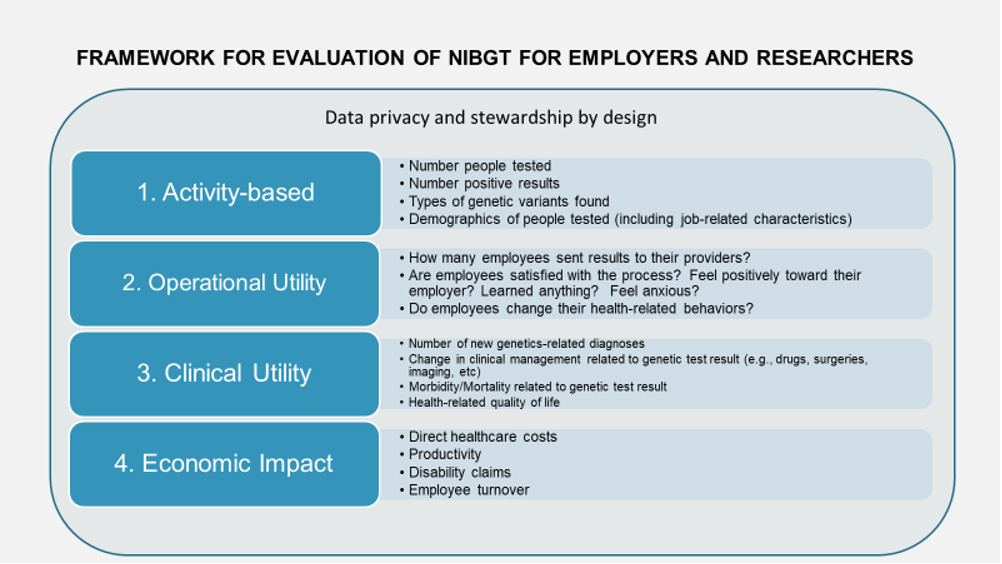 Patricia A. Deverka, MD, Executive Manager, Deverka Consulting
Patricia A. Deverka, MD, Executive Manager, Deverka Consulting
Marc S. Williams, MD, Director Emeritus Genomic Medicine Institute, Geisinger
The science behind genetic testing and the applicability of such tests in managing population health is expanding at a rapid pace. At the same time, the costs of tests are coming down. For employers, this may be the right time to reassess costs versus benefits of employee wide genetic testing. What types of genetic tests carry the highest potential for actionable, evidence-based interventions and thus may have the greatest impact on population health? Can genetic testing lead to improved health outcomes through more personalized interventions and long-term cost savings? How will employers know whether their support of genetic testing programs is delivering value to their employees and a return on their investment? A new white paper posted here answers these questions for employers and other stakeholders.
Background
Stakeholders Assessing Genetics with Employers (SAGE) was a federally funded research project designed to characterize the current state of employer-sponsored genetic testing, particularly in the context of wellness programs. The National Human Genome Research Institute funded a one-year study to support the development of frameworks that could be used by employers and researchers to guide informed decision-making and standardize process and outcomes investigations. The first framework is in the form of a checklist for employers interested in aligning their selection of genetic testing programs with their overall investment in employee health and well-being. The second framework targets both employers and researchers that want to develop robust evidence demonstrating the short and long-term impacts of genetic testing in measurement terms that are meaningful to employers and employees. If these frameworks are adopted in real-world decision-making and future research studies, employees are more likely to benefit in terms of improved health and well-being, and there will be a stronger evidence base to guide employer investment decisions in wellness programs that include genetic testing.
We are at a critical juncture in employer-sponsored wellness programs to both engage employees in their health while also demonstrating how these programs can be most effective in specific employer contexts. While there is a rich literature describing best practices for implementing and evaluating wellness initiatives, there is limited understanding of the relative contributions of genetic testing to these efforts. Therefore, the SAGE project addressed the following specific questions:
- What are the experiences, insights, and outcomes from current genetic testing programs offered by employers as part of wellness programs?
- What is the legal and policy environment shaping both program implementation and data sharing in support of research to evaluate the impact of genetic testing programs?
- Is there sufficient evidence to support genetic testing as part of company wellness programs, and if so, what genetic tests would be appropriate given corporate wellness goals?
Approach and Findings
This white paper addresses each of these objectives in separate, but inter-related sections that reflect the specific research questions and methods used by the research team. First, we defined the scope of our white paper as focusing on “non-indication based genetic testing” (NIBGT) that occurs as part of employer-sponsored wellness programs, while acknowledging that there is a separate process for assessing and covering medically-indicated genetic testing as part of health insurance. To advance understanding of the types of genetic tests and marketing claims currently represented online to employers, we summarized findings from an internet-based study of all the genetic testing vendors in this space. Building on this foundational description of the marketplace, we interviewed a subset of vendor representatives, employer-based purchasers and wellness program researchers to understand critical success factors and major challenges. Conclusions from these interviews supported the notion that while interest in NIBGT is potentially high, there is limited understanding of the risks and benefits of NIBGT and a clear need for better information and best practices to guide future employer adoption in wellness programs.
Prior to developing our recommendations, SAGE researchers conducted a comprehensive review of the federal laws and regulations potentially affecting genetic testing offered as part of wellness programs (e.g., the Affordable Care Act, the Americans with Disabilities Act, HIPAA and the Genetic Information Nondiscrimination Act). The legal picture is currently not entirely clear; however, the most critical factors are ensuring the voluntariness of the program as well as prohibiting employer access to employees’ genetic test results. In addition, the use of incentives for participation in NIBGT is not permissible, particularly when tied to sharing genetic test results with the employer. Finally, if employers want to share aggregated data to support studies of NIBGT impact on clinical and economic outcomes, employers need to proceed cautiously given the current legal environment. Policy education for both employers and employees will be required before such studies are feasible.
Frameworks
The first framework developed by SAGE researchers consists of a list of questions for employers who are contemplating offering NIBGT as part of their wellness program offering. The four areas to be considered are: 1.) Defining wellness program goals in the context of NIBGT; 2.) The specific types of genetic tests to be offered to employees; 3.) Legal and policy considerations to mitigate liability risks and build trust; and 4.) The types of evidence employers should request to ensure that their NIBGT goals are achieved. Genetics experts on the SAGE team then applied the two frameworks to six different categories of tests commonly offered by current NIBGT vendors: Health-related; Pharmacogenomic; Traits and Conditions; Fitness; Nutrigenomics; Ancestry. For each category a brief evaluation of each framework question above is presented and are intended to be illustrative of how a decision maker could collect and prioritize information needed to make an informed decision and could guide questions for prospective vendors. The result is a list of genetic tests that can be reviewed by employers considering their wellness program goals and evidence requirements.
Recognizing that there are few studies supporting the claims of employee benefits and harms from participating in NIBGT, the second framework focuses on how employers and researchers interested in evaluating these assertions can effectively close the evidence gaps. The types of research questions and specific process and outcome measures are described for four levels of evaluation, although each level is not intended to be viewed necessarily as stand-alone. These levels correspond to our theory that genetic test results must lead to different beliefs, behaviors, and actions to have the intended positive effects on employee engagement, as well as health and economic outcomes. While interested parties should consult the white paper for a more detailed description of each evaluation level, the figure below illustrates how the first level focuses on program activities as gauged by test uptake and results, while the second level focuses on measures of testing impact at the individual employee level, an assessment we labeled “operational utility.” The third level addresses the clinical utility of the test results in terms of changes in clinical management and health outcomes, while the fourth level focuses on measuring the direct and indirect costs of genetic testing implementation. Any evaluation will need to be conducted in an environment optimized for data privacy and data stewardship.
Conclusions
This white paper provides a substantive assessment of NIBGT in corporate wellness programs, and it is intended to provide useful information for employers interested in implementing NIBGT successfully. The two frameworks developed by the SAGE team can be used to ensure more informed employer and employee decision-making, while also contributing to the expansion of the evidence base demonstrating the value of NIBGT for employees and employers.

